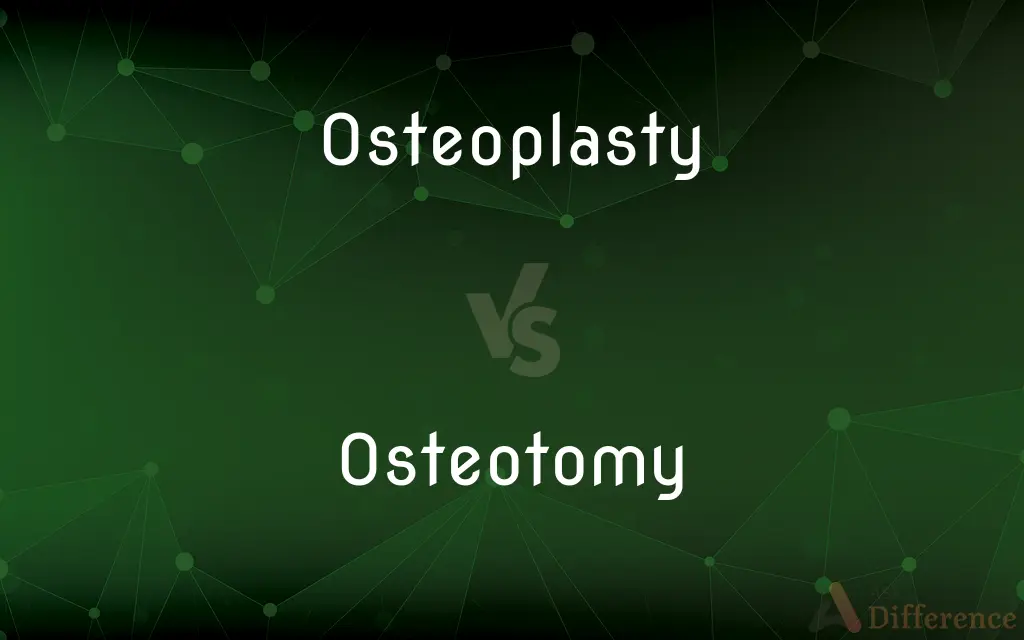Osteoplasty vs. Osteotomy — What's the Difference?
Edited by Tayyaba Rehman — By Urooj Arif — Updated on April 25, 2024
Osteoplasty involves bone reshaping or smoothing, primarily for relieving pain, while osteotomy entails cutting and realigning bones to correct deformities.

Difference Between Osteoplasty and Osteotomy
Table of Contents
ADVERTISEMENT
Key Differences
Osteoplasty is a surgical procedure aimed at modifying the surface of bones, often to alleviate pain or prepare the bone for further surgical interventions. On the other hand, osteotomy involves the surgical cutting of bones to change their alignment or length, typically used to correct bone deformities or relieve stress on a joint.
Osteoplasty is commonly used in procedures like smoothing out bone spurs or reshaping bones in joint replacement preparations, which helps in pain management and improves mobility. Whereas osteotomy is more invasive, requiring the cutting and sometimes the removal of bone segments, followed by realignment and fixation with screws, plates, or pins.
The recovery time for osteoplasty generally tends to be shorter, as the procedure is less invasive and focuses more on surface modifications. Conversely, osteotomy involves significant alterations to the bone structure, leading to longer recovery periods and often more intense rehabilitation to restore function.
Osteoplasty is often utilized in dental and orthopedic surgeries, particularly useful in treating bone tumors and modifying bone structures in limited areas. Osteotomy, however, has a broader application in orthopedics, particularly in pediatric cases for correcting congenital bone alignment issues and in adults for addressing arthritic damage.
In terms of outcomes, osteoplasty is aimed at providing symptomatic relief, especially in cases where bone irregularities cause pain or limit function. On the other hand, osteotomy seeks to achieve more permanent corrective outcomes, addressing underlying skeletal deformities and potentially preventing further joint or bone complications.
ADVERTISEMENT
Comparison Chart
Definition
Surgical modification of bone surface
Surgical cutting and realignment of bones
Primary Purpose
Pain relief, preparation for further surgery
Correction of deformities, stress relief
Invasiveness
Less invasive, surface modifications
More invasive, involves cutting/removal of bone
Recovery Time
Generally shorter
Longer, requires more rehabilitation
Typical Applications
Dental and orthopedic surgeries
Pediatric and adult orthopedics
Compare with Definitions
Osteoplasty
A surgical procedure to reshape or smooth bone surfaces.
The surgeon performed osteoplasty to smooth out the bone spurs that were causing the patient discomfort.
Osteotomy
A surgical procedure involving the cutting of bones to correct alignment.
The osteotomy realigned her hip to alleviate the severe arthritis symptoms.
Osteoplasty
Often performed to alleviate pain caused by bone irregularities.
Her osteoplasty significantly reduced the pain from her bone spur.
Osteotomy
Often used to correct congenital deformities.
Pediatric surgeons perform osteotomies to correct misaligned leg bones in children.
Osteoplasty
Can be used in treating bone tumors by reshaping affected areas.
Osteoplasty was part of his treatment plan for the benign bone tumor.
Osteotomy
Requires internal fixation with hardware post-surgery.
After the osteotomy, her bones were stabilized with plates and screws.
Osteoplasty
Used to prepare bones for further surgical procedures.
Osteoplasty was necessary before the knee replacement to ensure the best fit for the new joint.
Osteotomy
Targets long-term correction of skeletal issues.
His osteotomy was planned to prevent future complications from his knee deformity.
Osteoplasty
Involves minimal bone removal, focusing on surface.
Osteoplasty involves careful contouring of the bone surface, rather than extensive cutting.
Osteotomy
Utilized in severe cases where other treatments have failed.
Osteotomy was the last resort to manage his chronic joint pain.
Osteoplasty
Osteoplasty is the branch of surgery concerned with bone repair or bone grafting. It is the surgical alteration or reshaping of bone.
Osteotomy
An osteotomy is a surgical operation whereby a bone is cut to shorten or lengthen it or to change its alignment. It is sometimes performed to correct a hallux valgus, or to straighten a bone that has healed crookedly following a fracture.
Osteoplasty
Surgical repair or alteration of bone.
Osteotomy
Surgical division or sectioning of bone.
Osteoplasty
(surgery) Surgery to repair, modify or graft bone or bony structures.
Osteotomy
(surgery) The surgical procedure of cutting a bone. This is often performed to either lengthen, shorten, or straighten a bone.
Osteoplasty
An operation or process by which the total or partial loss of a bone is remedied.
Osteotomy
The dissection or anatomy of bones; osteology.
Osteotomy
The operation of dividing a bone or of cutting a piece out of it, - done to remedy deformity, etc.
Osteotomy
Surgical sectioning of bone
Common Curiosities
What is osteoplasty primarily used for?
Osteoplasty is primarily used for smoothing bone surfaces to relieve pain or prepare for other surgical procedures.
How does osteotomy differ from osteoplasty in terms of purpose?
Osteotomy is performed to correct bone deformities and realign bones, whereas osteoplasty focuses on surface modifications for pain relief.
Can osteoplasty be used to treat bone tumors?
Yes, osteoplasty can be used to reshape and smooth areas affected by bone tumors.
What are common applications of osteotomy?
Osteotomy is commonly used in orthopedics to correct congenital deformities in children and to address arthritic damage in adults.
How does osteoplasty improve joint replacement outcomes?
Osteoplasty prepares the bone surface, ensuring a better fit and alignment for joint replacements, potentially improving outcomes.
What is the recovery like for osteoplasty compared to osteotomy?
Recovery from osteoplasty is usually quicker and less complicated compared to osteotomy, which may require longer and more intense rehabilitation.
What type of fixation is used in osteotomy?
Internal fixation devices such as screws, plates, or pins are typically used in osteotomy to maintain bone alignment post-surgery.
Is osteotomy a common procedure for all age groups?
Yes, osteotomy is used across various age groups, particularly in pediatric orthopedics for congenital issues and in adults for degenerative conditions.
What is the level of invasiveness in osteoplasty compared to osteotomy?
Osteoplasty is less invasive, focusing on bone surface, whereas osteotomy involves more extensive bone cutting and removal.
Can osteoplasty alone correct bone deformities?
No, osteoplasty is not typically used to correct bone deformities but rather to smooth surfaces for pain relief or surgical preparation.
Who performs osteoplasty and osteotomy?
Both procedures are performed by orthopedic surgeons, often with specialization in specific areas like pediatrics or joint replacement.
Are there alternatives to osteotomy for correcting bone deformities?
Yes, depending on the case, non-surgical treatments like braces or physical therapy might be considered before opting for osteotomy.
Is osteoplasty suitable for all bone-related issues?
Osteoplasty is not suitable for all bone-related issues, particularly where major structural corrections are needed; it's more focused on surface conditions and minor modifications.
How does osteoplasty help in managing arthritis?
Osteoplasty can smooth out irregular bone growths and spurs that contribute to arthritis pain, improving joint function and comfort.
What risks are associated with osteotomy?
Risks of osteotomy include infection, nerve damage, blood loss, and complications from internal fixation devices.
Share Your Discovery

Previous Comparison
Bandoneon vs. Concertina
Next Comparison
Glowworm vs. FireflyAuthor Spotlight
Written by
Urooj ArifUrooj is a skilled content writer at Ask Difference, known for her exceptional ability to simplify complex topics into engaging and informative content. With a passion for research and a flair for clear, concise writing, she consistently delivers articles that resonate with our diverse audience.
Edited by
Tayyaba RehmanTayyaba Rehman is a distinguished writer, currently serving as a primary contributor to askdifference.com. As a researcher in semantics and etymology, Tayyaba's passion for the complexity of languages and their distinctions has found a perfect home on the platform. Tayyaba delves into the intricacies of language, distinguishing between commonly confused words and phrases, thereby providing clarity for readers worldwide.














































